动画的12条黄金法则
动画运动的十二法则
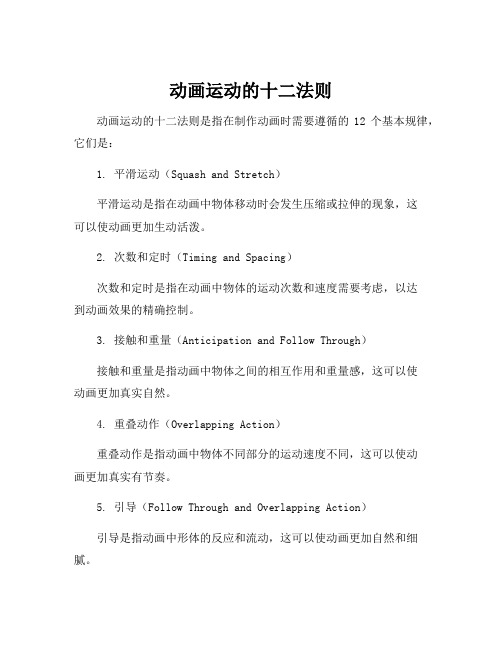
动画运动的十二法则动画运动的十二法则是指在制作动画时需要遵循的12个基本规律,它们是:1. 平滑运动(Squash and Stretch)平滑运动是指在动画中物体移动时会发生压缩或拉伸的现象,这可以使动画更加生动活泼。
2. 次数和定时(Timing and Spacing)次数和定时是指在动画中物体的运动次数和速度需要考虑,以达到动画效果的精确控制。
3. 接触和重量(Anticipation and Follow Through)接触和重量是指动画中物体之间的相互作用和重量感,这可以使动画更加真实自然。
4. 重叠动作(Overlapping Action)重叠动作是指动画中物体不同部分的运动速度不同,这可以使动画更加真实有节奏。
5. 引导(Follow Through and Overlapping Action)引导是指动画中形体的反应和流动,这可以使动画更加自然和细腻。
6. 收缩(Slow In and Slow Out)收缩是指动画中物体的加速和减速过程,这可以使动画更加平稳自然。
7. 弹性(Arc)弹性是指动画中物体的弯曲和扭转,这可以使动画更加流畅和具有冲击力。
8. 层次(Exaggeration)层次是指在动画中夸张物体的形态和动作,这可以使动画更加有趣生动。
9. 画面平衡(Secondary Action)画面平衡是指在动画中添加辅助动作来丰富画面,这可以使画面更加平衡。
10. 反向动作(Appeal)反向动作是指在动画中强调物体的特点,这可以使动画更加有吸引力和感染力。
11. 符合语境(Staging)符合语境是指在动画中物体的形态和动作要符合剧情和场景,这可以使动画更加自然完整。
12. 色彩和光影(Color and Light)色彩和光影是指在动画中反映物体的颜色和光影效果,这可以使动画更加真实和具有立体感。
在制作动画时需要遵循以上十二法则,并通过不断的练习和实践,才能不断提升自己的动画制作技能,创造更加生动、绚丽的动画作品。
迪士尼动画黄金法则

为什么要学习这十二项动画法则?
早期(20世纪初)的动画片中角色的动态 经常缺乏真实感,往往无法让观众相信角 色的真实性。于是迪士尼动画工作室的动 画师们经年累月研究、观察、讨论而逐渐 形成了能够表现角色动作真实、生动的 『动画法则』。如今这些法则已是无论2D 或3D的专业角色动画师心中的「金科玉 律」,是业余动画师要进入专业领域的最 基本专业知识。
跟随与动作重叠(Follow Through & Overlapping Action)
图2
跟随与动作重叠(Follow Through & Overlapping Action)
图3
慢入、慢出(Slow in & Slow out)
六、慢入、慢出(Slow in & Slow out) 自然界中无论是生物的动作或其他现象都极少有等速运行 的状态,单单就人的肢体动作而言,要是都以等速进行, 看起来会比较像机器人而不象人了。 在镜头的运作表现上也应该特别着重此原则。
识控制下的自然飘动或延迟动作的物理现象。
跟随与动作重叠(Follow Through & Overlapping Action)
动作重叠则是指角色肢体各部位在表演动作过程中的时 间差。比如说我们在反应背后招唤的声音,我们可能会先 动眼睛,再转回头,头转到一半时再转动肩膀。 总之,此两点是活化动画角色及其重要的观念。 图1
夸张化(Exaggeration)
十、夸张化(Exaggeration) 动画或戏剧表演并非单是反映现实世界,而是汇集了人生 中的各种高潮与意外的可能性,有时往往更是表现人生中 不可能发生的事。 尤其动画片的肢体表演方式更是宽广,细致时可以非常细 致,夸张时则是飞天遁地,无所不能。 就一般而言,动画表演更近似早期的默片。建议各位多 多参考查理卓别林(Charlie Chaplin)的默剧电影,很有 意思的。
迪士尼12黄金法则
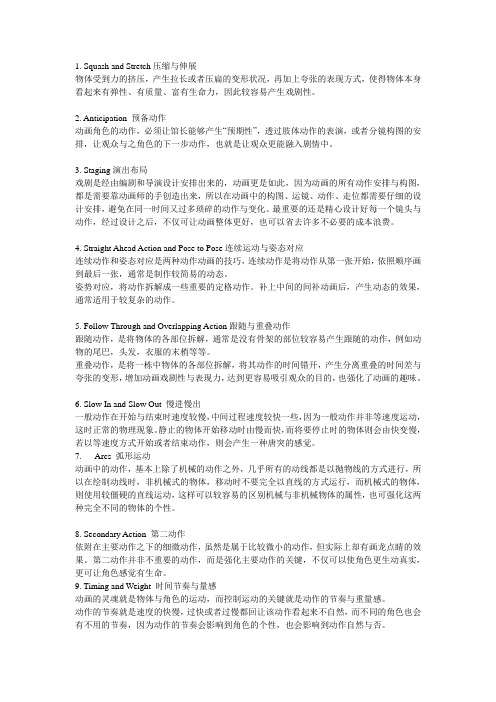
1. Squash and Stretch压缩与伸展物体受到力的挤压,产生拉长或者压扁的变形状况,再加上夸张的表现方式,使得物体本身看起来有弹性、有质量、富有生命力,因此较容易产生戏剧性。
2. Anticipation 预备动作动画角色的动作,必须让馆长能够产生“预期性”,透过肢体动作的表演,或者分镜构图的安排,让观众与之角色的下一步动作,也就是让观众更能融入剧情中。
3. Staging演出布局戏剧是经由编剧和导演设计安排出来的,动画更是如此,因为动画的所有动作安排与构图,都是需要靠动画师的手创造出来,所以在动画中的构图、运镜、动作、走位都需要仔细的设计安排,避免在同一时间又过多琐碎的动作与变化。
最重要的还是精心设计好每一个镜头与动作,经过设计之后,不仅可让动画整体更好,也可以省去许多不必要的成本浪费。
4. Straight Ahead Action and Pose to Pose连续运动与姿态对应连续动作和姿态对应是两种动作动画的技巧,连续动作是将动作从第一张开始,依照顺序画到最后一张,通常是制作较简易的动态。
姿势对应,将动作拆解成一些重要的定格动作。
补上中间的间补动画后,产生动态的效果,通常适用于较复杂的动作。
5. Follow Through and Overlapping Action跟随与重叠动作跟随动作,是将物体的各部位拆解,通常是没有骨架的部位较容易产生跟随的动作,例如动物的尾巴,头发,衣服的末梢等等。
重叠动作,是将一栋中物体的各部位拆解,将其动作的时间错开,产生分离重叠的时间差与夸张的变形,增加动画戏剧性与表现力,达到更容易吸引观众的目的,也强化了动画的趣味。
6. Slow In and Slow Out 慢进慢出一般动作在开始与结束时速度较慢,中间过程速度较快一些,因为一般动作并非等速度运动,这时正常的物理现象。
静止的物体开始移动时由慢而快,而将要停止时的物体则会由快变慢,若以等速度方式开始或者结束动作,则会产生一种唐突的感觉。
动画运动规律黄金12法则
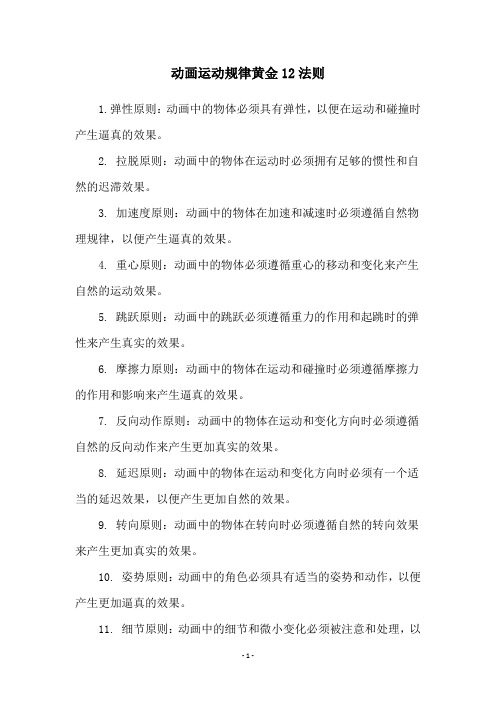
动画运动规律黄金12法则
1.弹性原则:动画中的物体必须具有弹性,以便在运动和碰撞时产生逼真的效果。
2. 拉脱原则:动画中的物体在运动时必须拥有足够的惯性和自然的迟滞效果。
3. 加速度原则:动画中的物体在加速和减速时必须遵循自然物理规律,以便产生逼真的效果。
4. 重心原则:动画中的物体必须遵循重心的移动和变化来产生自然的运动效果。
5. 跳跃原则:动画中的跳跃必须遵循重力的作用和起跳时的弹性来产生真实的效果。
6. 摩擦力原则:动画中的物体在运动和碰撞时必须遵循摩擦力的作用和影响来产生逼真的效果。
7. 反向动作原则:动画中的物体在运动和变化方向时必须遵循自然的反向动作来产生更加真实的效果。
8. 延迟原则:动画中的物体在运动和变化方向时必须有一个适当的延迟效果,以便产生更加自然的效果。
9. 转向原则:动画中的物体在转向时必须遵循自然的转向效果来产生更加真实的效果。
10. 姿势原则:动画中的角色必须具有适当的姿势和动作,以便产生更加逼真的效果。
11. 细节原则:动画中的细节和微小变化必须被注意和处理,以
便产生更加真实的效果。
12. 情感原则:动画中的角色必须具有适当的情感和表情,以便传达更加精确和深刻的信息。
动画的12项基本法则

动画的12项基本法则动画的12项基本法则是指在创作动画过程中应该遵循的一系列原则,这些原则可以帮助动画师制作出更加生动、有趣的动画作品。
1. 漫画的法则:这个法则指的是要在动画中创造出一种夸张的效果,让人们感到兴奋、惊喜或者是惊恐的情绪,让人们能够真正地投入到故事中去。
2. 反向动作的法则:这个法则指的是在动画中要创造出逼真的动作,需要考虑到物体的惯性和重量感,让人们感到物体的真实性。
3. 动作的曲线法则:这个法则指的是在动画中要创造出流畅的动作,需要将动作分解成多个关键帧,使得动作的曲线更加自然流畅。
4. 延迟和重叠的法则:这个法则指的是在动画中要注意动作之间的延迟和重叠,这样可以让动画更加真实,也可以增加动画的趣味性。
5. 动画的繁琐法则:这个法则指的是在动画中要注意细节,包括人物的表情、手势、眼神等等,这些细节能够让动画更加生动、有趣。
6. 赛博格法则:这个法则指的是在动画中要注意到机器和人体的区别,需要将机器的动作创造得更加平滑,而将人体的动作创造得更具有自然性。
7. 表现的法则:这个法则指的是在动画中要注重人物的表现,要让人们感到人物的情感变化,这样才能让故事更加生动。
8. 色彩的法则:这个法则指的是在动画中要选择合适的色彩,包括人物的服装、背景、灯光等等,这些色彩能够帮助表达故事的情感。
9. 音效的法则:这个法则指的是在动画中要注意到音效的使用,包括人物的声音、环境的声音等等,这些声音能够增强动画的气氛。
10. 拍摄的法则:这个法则指的是在动画中要注意到拍摄的角度,包括人物的角度、摄像机的角度等等,这些角度能够让人们更好地理解故事。
11. 故事的法则:这个法则指的是在动画中要注意故事的构建,包括人物的个性、情节的设置等等,这些构建能够让故事更加有趣、吸引人。
12. 速度的法则:这个法则指的是在动画中要注意速度的变化,包括人物的动作速度、摄像机的移动速度等等,这些变化能够让动画更加生动、有趣。
动画运动12法则

动画运动12法则
动画运动12法则是一套经典的动画原则,用于指导动画师创
作出流畅、生动和有趣的动画。
这些法则是由迪斯尼的动画师弗兰克·托马斯(Frank Thomas)和欧利·约翰斯顿(Ollie Johnston)提出的,并被广泛应用于动画制作中。
以下是这些
法则的简要介绍:
1. 延迟:在动画过渡时,让物体的动作稍微延迟一下,以增加动画的真实感和流畅度。
2. 加速和减速:物体在开始和结束时应该有加速和减速的感觉,以模拟真实世界中的物体运动。
3. 弹跳:物体在反弹时会有一些额外的动作,这个额外的动作会根据物体的弹性决定。
4. 关键帧:关键帧是动画片段中最重要的帧,它定义了物体的主要动作和位置。
5. 相对动作:物体之间的动作应该相互配合,以增加动画的连贯性和真实感。
6. 曲线:物体的运动应该遵循自然曲线,而不是直线,以增加动画的流畅度。
7. 姿势:物体的姿势应该能够清晰地传达动画的意图,同时也要符合物体的特性和重心。
8. 弧线:物体的运动应该遵循弧线,以增加动画的流畅度和真实感。
9. 预演:在制作动画之前,用手画出草图,预先规划动画的基本动作和过渡。
10. 互补动作:物体的不同部分应该相互配合,形成动画的整体效果。
11. 重叠:物体不同部分的运动速度可能不同,这种不同的速度差异可以增加动画的真实感。
12. 拖尾:快速运动的物体会留下拖尾效果,这个效果可以增加动画的速度感和流畅度。
这些法则旨在帮助动画师创造出更好的动画作品,但并不是固定的规则,而是作为指导原则供参考。
不同的动画风格和需求会有不同的应用方式。
动画运动12法则
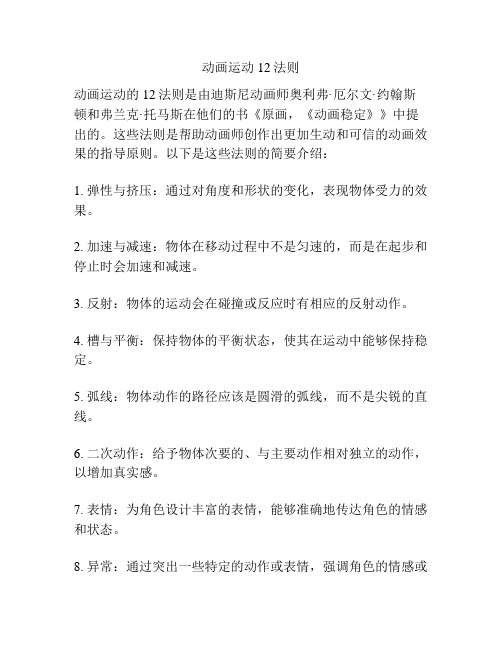
动画运动12法则
动画运动的12法则是由迪斯尼动画师奥利弗·厄尔文·约翰斯顿和弗兰克·托马斯在他们的书《原画,《动画稳定》》中提出的。
这些法则是帮助动画师创作出更加生动和可信的动画效果的指导原则。
以下是这些法则的简要介绍:
1. 弹性与挤压:通过对角度和形状的变化,表现物体受力的效果。
2. 加速与减速:物体在移动过程中不是匀速的,而是在起步和停止时会加速和减速。
3. 反射:物体的运动会在碰撞或反应时有相应的反射动作。
4. 槽与平衡:保持物体的平衡状态,使其在运动中能够保持稳定。
5. 弧线:物体动作的路径应该是圆滑的弧线,而不是尖锐的直线。
6. 二次动作:给予物体次要的、与主要动作相对独立的动作,以增加真实感。
7. 表情:为角色设计丰富的表情,能够准确地传达角色的情感和状态。
8. 异常:通过突出一些特定的动作或表情,强调角色的情感或
状态。
9. 直观性:动画的动作和表情应该能够直观地传达信息,不需要额外的解释。
10. 可反转性:物体在运动过程中应该有明确的起点和终点,以确保动作的连贯性。
11. 多向性:给角色的动作和表情增加多个维度,使其更加生动和立体。
12. 摄像机镜头:动画的布置应该考虑到摄像机的视角,以获得更好的观赏效果。
动画运动12法则

动画运动12法则摘要:1.引言2.动画运动12 法则的起源和发展3.12 法则的具体内容3.1 淡入淡出3.2 慢入慢出3.3 弹跳3.4 滑动3.5 缩放3.6 旋转3.7 振动3.8 波形3.9 弹簧3.10 惯性3.11 重力3.12 碰撞4.12 法则在动画制作中的应用5.12 法则对于动画创作的意义6.总结正文:动画运动12 法则,是指在动画制作中,为了使动画更加自然流畅,所遵循的12 条基本原则。
这些原则自20 世纪20 年代起,经过多位动画大师的研究与发展,逐渐形成了这套理论体系。
12 法则对于动画创作有着重要的指导意义,使得动画作品在视觉表现上更加丰富多样。
1.引言动画作为一门视觉艺术,运动是其表现手法的重要组成部分。
如何使动画中的运动更加自然、流畅,成为了动画制作的关键问题。
动画运动12 法则正是为了解决这个问题而提出的。
2.动画运动12 法则的起源和发展动画运动12 法则最早可以追溯到20 世纪20 年代,华纳兄弟公司的动画师奥利弗·约翰·怀尔斯(Oliver Johnson Wiley)提出了“淡入淡出”和“慢入慢出”两个法则。
随着动画技术的发展,更多的法则被不断提出和完善,形成了今天的12 法则体系。
3.12 法则的具体内容动画运动12 法则包括以下内容:3.1 淡入淡出:物体在出现和消失时,应逐渐变得模糊或清晰。
3.2 慢入慢出:物体在开始和结束运动时,速度应逐渐变化。
3.3 弹跳:物体在弹性运动时,应遵循胡克定律,恢复力与伸缩量成正比。
3.4 滑动:物体在滑动过程中,应保持摩擦力的恒定。
3.5 缩放:物体在缩放过程中,应保持其形状不变。
3.6 旋转:物体的旋转运动应遵循角动量守恒定律。
3.7 振动:物体的振动运动应具有周期性、往复性。
3.8 波形:物体的运动应呈波动状,如水波、声波等。
3.9 弹簧:物体的运动应类似弹簧的伸缩。
3.10 惯性:物体在运动过程中,应保持其原有的运动状态。
12条动画法则
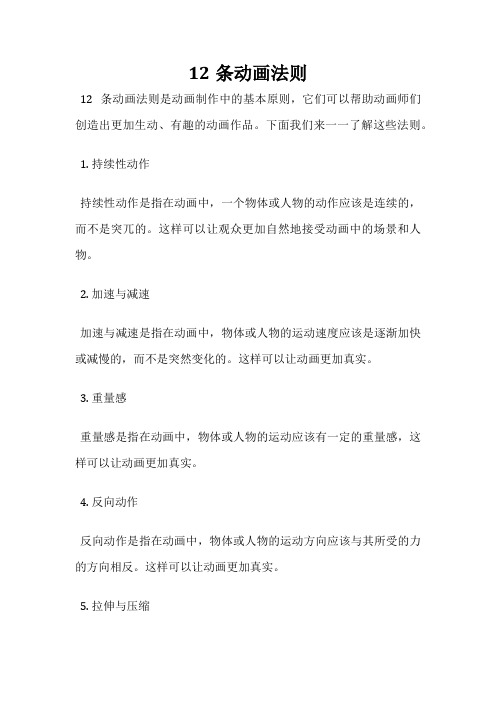
12条动画法则12条动画法则是动画制作中的基本原则,它们可以帮助动画师们创造出更加生动、有趣的动画作品。
下面我们来一一了解这些法则。
1. 持续性动作持续性动作是指在动画中,一个物体或人物的动作应该是连续的,而不是突兀的。
这样可以让观众更加自然地接受动画中的场景和人物。
2. 加速与减速加速与减速是指在动画中,物体或人物的运动速度应该是逐渐加快或减慢的,而不是突然变化的。
这样可以让动画更加真实。
3. 重量感重量感是指在动画中,物体或人物的运动应该有一定的重量感,这样可以让动画更加真实。
4. 反向动作反向动作是指在动画中,物体或人物的运动方向应该与其所受的力的方向相反。
这样可以让动画更加真实。
5. 拉伸与压缩拉伸与压缩是指在动画中,物体或人物在运动过程中会因为速度的变化而发生形变。
这样可以让动画更加生动。
6. 次要动作次要动作是指在动画中,物体或人物的运动过程中会产生一些次要的动作,比如头发、衣服等的晃动。
这样可以让动画更加生动。
7. 引导线引导线是指在动画中,物体或人物的运动轨迹应该是流畅的,而不是突兀的。
这样可以让动画更加自然。
8. 呼吸呼吸是指在动画中,人物的呼吸应该是自然的,这样可以让动画更加真实。
9. 反复反复是指在动画中,某些动作可以反复出现,比如人物的眨眼、摇头等。
这样可以让动画更加生动。
10. 色彩色彩是指在动画中,色彩的运用应该是合理的,可以表现出不同的情感和氛围。
11. 立体感立体感是指在动画中,物体或人物的立体感应该是明显的,这样可以让动画更加真实。
12. 意识流意识流是指在动画中,人物的内心活动应该通过一些特殊的手法来表现出来,比如梦境、幻觉等。
这样可以让动画更加有趣。
12条动画法则是动画制作中的基本原则,它们可以帮助动画师们创造出更加生动、有趣的动画作品。
在动画制作中,我们应该根据不同的情况来灵活运用这些法则,以创造出更加优秀的动画作品。
迪士尼动画十二黄金法则

相同的原理也可以用此方式运用在角色上, 如下图:
二、 预备动作(Anticipation)以及 缓冲动作(Settle Cushion) •预备动作的用意有两项:一是为了要引起观众的注意,要观众 准备好看清楚角色的肢体表演,以免错失了故事情节;二是为了 蓄积动作所需的动能。 •预备动作的方向往往是与主动作方向相反。 •预备动作不一定要很夸大,也是可以很细腻的。 •基本上,主动作小或慢时,其预备动作也就小且细腻;主动作 大或快时,其预备动作也就相对大且历时较久。
• Appeal 字面上的意思是有吸引力的,讨人喜欢的,而其 在此的意思则是符合角色个性的表演方式,英雄要表现的 像英雄,傻瓜要表现的像傻瓜,角色应该具有吸引观众的独特个性和外表。当观众看到 角色的表演时会不会给他们留下深刻的印象 ,这往往取决 于动画设计师在造型设计上是否有独特之处,表情上是否 富于变化,动作表现上是不是有活力等等,以及一切可以 抓住观众目光的元素。
预备动作也是可以很细腻的。
此外,在多数动作之后都会有一个舒缓下来的过 程,不会突然停止,这我们称之为缓冲动作 (Settle Cushion)。
图1
图2
跟随动作指的是如动物耳朵、衣服、毛发等在角 色无意识控制下的自然飘动或延迟动作的物理现 象。
六、慢入、慢出(Slow in & Slow out)
一、 挤压与伸展 Squash and Stretch 自然界中,除了如铁球、石头等刚体外,其他的物体或生命 体在与他物碰撞或自行运动时,都多多少少会产生变形的现 象,也就是挤压与伸展。藉由把这种自然的物理现象夸大的表 现,我们得到动画世界中独一无二的趣味性。 最典型的例子就是跳跃的皮球(Bouncing Ball)。
•自然界中无论是生物的动作或其他现象都极少有等速运行的状 态,单单就人的肢体动作而言,要是都以等速进行,看起来会比 较像机器人而不象人了。 •在镜头的运作表现上也应该特别着重此原则。
动画运动12法则

动画运动12法则动画运动12法则在动画制作中具有至关重要的作用,它们为动画师提供了一系列关于如何让动画看起来更真实、生动和有趣的指导原则。
以下是对这12条法则的详细解释。
1.挤压和拉伸:在动画中,对物体进行挤压和拉伸可以使其更具表现力。
例如,角色的面部表情在高兴时可以变得更圆润,而在生气时可以变得更尖锐。
2.弧线运动:弧线运动可以使动画更具流畅性。
例如,在角色行走时,其身体和四肢的运动轨迹可以呈现弧线形状。
3.跟随运动:跟随运动是指一个物体在另一个物体运动过程中,以其为基础进行相应运动。
例如,在人物跑步时,其衣物和头发也会随之产生相应的飘动。
4.预加载:预加载是指在动画开始前,为物体提前准备一定的运动速度。
这样可以使其在动画过程中更加自然。
例如,在角色跳跃前,可以先让其在原地快速滚动,以产生更大的跳跃速度。
5.缓动和缓冲:在动画中,缓动和缓冲可以使物体在运动过程中更加平滑。
例如,在角色停止运动时,可以使其运动速度逐渐减慢,而不会突然停下来。
6.反向运动:反向运动是指物体在受到外力作用时,其运动方向与受力方向相反。
例如,在人物摔倒时,其身体会因受到地面的反弹力而迅速弹起。
7.弹性运动:弹性运动是指物体在受到外力作用后,恢复原状的过程。
例如,在角色跳跃时,其身体会在落地后因地面反弹而产生向上的弹跳。
8.重量和惯性:在动画中,物体具有重量和惯性特性,可以使其运动更加真实。
例如,重型物体在运动时,需要更大的力才能改变其运动状态。
9.摩擦力和空气阻力:摩擦力和空气阻力会影响物体的运动速度和方向。
例如,在角色滑行时,摩擦力会使其速度逐渐减慢。
10.虚拟运动:虚拟运动是指动画中物体受到虚拟力的作用而产生的运动。
例如,在魔法师施法时,其手中的魔杖会因虚拟力的作用而产生弯曲。
11.跟随镜头:在动画中,跟随镜头可以使观众更好地关注角色和场景。
例如,在追逐场景中,镜头会随着角色的运动而不断变换视角。
12.人物和场景的互动:人物与场景的互动可以增加动画的真实感。
12动画法则

1. Squash and Stretch 挤压与拉伸入门动画的第一课就是小球的动画,运用到的就是这个原理,如图:动画animation这个词汇来源于animate,意思是使...栩栩如生地动作和赋予…以生命的意思。
第一条法则的神奇之处就是赋予了物品弹性,使动作不在呆板,在人们眼前这个球就仿佛是有生命的可爱的个体一样。
同理,这个法则可以运用到几乎所有的动画角色上来。
如:2.Anticipation预备动作:加入一反向的动作以加强正向动作的张力,借以表示下一个将要发生的动作。
例如这个手笔直的伸向远方的动作,一般人的动作是直接画A位置然后到B 位置。
但是为了加深观众对这个动作的印象,就会在AB中间插入一帧X。
这样会更有力度感。
预备动作是个神发明啊!!!让动画师们不仅仅只是对于现实生活动作的描摹,而是新的艺术创造。
一种崭新的只出现在动画师笔下的鲜活生命便诞生了。
预备动作的思路继续延续,发展了关键帧的强调动作。
例如表现小老鼠震惊的动作1-9中间会加入7这一个强调动作,然后再加入17 一个结尾动作。
使动作更有弹性。
3. Staging:所谓staging就是要清晰的表现动作的意图使之容易理解。
一般的,动作一次性呈现给观众的,但如果同时太多东西展示给观众的话,观众就不知道该把注意力放到哪里了,而动作就没有达到目的。
而Staging重要的检测方法是“动作剪影”。
物体或者角色的动作应该富有表现力,甚至只需要通过黑白影响对比就可以表达动作意图。
如果你不能通过动作剪影来理解某一个动作的意图,那这个动作的幅度就不够,或者说意图就不够明显,可以考虑修改它了。
对于角色动画,很重要的一点就是要确认角色所做的每一个动作强度是否足够清晰的传达出所要表现的动作意图,从而观众是否能从中领会得到。
而且动画师也要避免同一角色得表演里由互相矛盾的地方。
譬如如果你想表现一个人很沮丧很悲伤的状况,可以设计角色做出弓着背,双手垂在身体两侧前方,镜头采用俯视的角度等等。
动画运动12法则

动画运动12法则动画运动的12法则是动画制作中常见的原则,包括:1.Squash and Stretch(挤压和拉伸):在动画中,物体在运动过程中会发生形状的变化,这种变化可以增加物体的真实感和动画的趣味性。
2.Anticipation(预备动作):在动画中,为了使动作看起来更加自然和真实,通常会先做一个相反的动作来预示下一步的动作。
3.Staging(布局):动画师需要考虑如何将角色和物体在画面中进行布局,以更好地呈现故事情节和角色的情感状态。
4.Straight ahead and pose to pose(连贯动作法和关键动作法):这是两种不同的动画制作方法,前者是一帧一帧地绘制动画,后者是先定义关键的动作,再绘制其他部分。
5.Follow through and Overlapping Action(跟随动作和重叠动作):在动画中,物体和角色的动作不是独立的,而是相互关联的。
重叠动作是指一个动作还没有完全结束,另一个动作已经开始,形成一种连续的视觉效果。
6.Slow in and slow out(缓入缓出):动画中的动作应该有一定的加速度和减速度,以使动作看起来更加自然和真实。
7.Arcs(弧形运动):在动画中,物体的运动轨迹通常不是直线的,而是弧形或曲线的。
这种运动方式可以使动画看起来更加自然和流畅。
8.Exaggeration(夸张):通过夸大角色的表情、动作和反应,可以使动画看起来更加有趣和生动。
9.Solid Drawing(视觉科学):在动画中,物体和角色的形状、比例和结构应该符合现实中的规律和人们的视觉习惯。
10.Appeal(吸引力):动画的角色和场景应该具有吸引力,能够吸引观众的注意力和情感共鸣。
11.Staging Performance and Presentation Modes(表演及呈像方式):动画的角色和场景需要与适当的摄影机运动相结合,以更好地呈现故事情节和角色的情感状态。
迪斯尼动画的金牌12法则
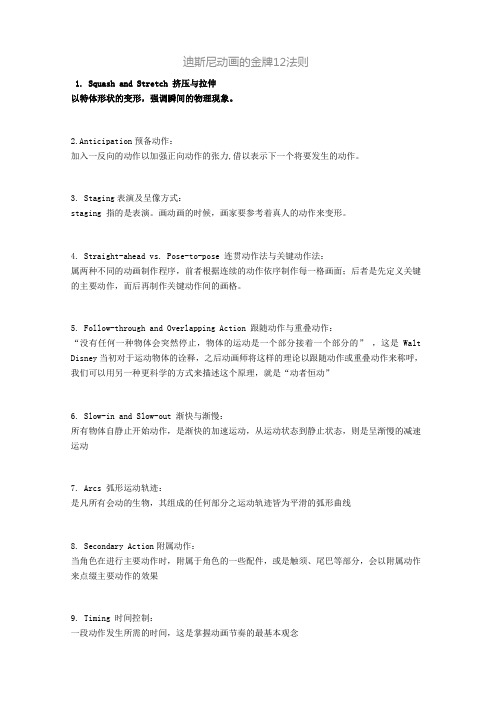
迪斯尼动画的金牌12法则1. Squash and Stretch 挤压与拉伸以特体形状的变形,强调瞬间的物理现象。
2.Anticipation预备动作:加入一反向的动作以加强正向动作的张力,借以表示下一个将要发生的动作。
3. Staging表演及呈像方式:staging 指的是表演。
画动画的时候,画家要参考着真人的动作来变形。
4. Straight-ahead vs. Pose-to-pose 连贯动作法与关键动作法:属两种不同的动画制作程序,前者根据连续的动作依序制作每一格画面;后者是先定义关键的主要动作,而后再制作关键动作间的画格。
5. Follow-through and Overlapping Action 跟随动作与重叠动作:“没有任何一种物体会突然停止,物体的运动是一个部分接着一个部分的” ,这是Walt Disney当初对于运动物体的诠释,之后动画师将这样的理论以跟随动作或重叠动作来称呼,我们可以用另一种更科学的方式来描述这个原理,就是“动者恒动”6. Slow-in and Slow-out 渐快与渐慢:所有物体自静止开始动作,是渐快的加速运动,从运动状态到静止状态,则是呈渐慢的减速运动7. Arcs 弧形运动轨迹:是凡所有会动的生物,其组成的任何部分之运动轨迹皆为平滑的弧形曲线8. Secondary Action附属动作:当角色在进行主要动作时,附属于角色的一些配件,或是触须、尾巴等部分,会以附属动作来点缀主要动作的效果9. Timing 时间控制:一段动作发生所需的时间,这是掌握动画节奏的最基本观念10. Exaggeration 夸张:利用挤压与伸展的效果、夸大的肢体动作、或是以加快或放慢动作来加乘角色的情绪及反应,这是动画有别于一般表演的重要元素11. Solid drawing 纯熟的手绘技巧:这是在传统手绘动画领域里,对于动画师的基本要求,然而在计算机动画领域,手绘已不再是动画师的工作内容12. Appeal 吸引力:当设计角色时,能够以造型或独特的姿态让观众直觉角色的属性,藉以提高观众对于角色的印象,例如高矮胖瘦可分别代表不同个性的角色除了以上12项基本法则,另外可以延伸出另一项重要的原则:13. Depth 深度:由于利用3D动画软件已经可以方便做出立体的效果,但是仍然可以擅用摄影机的功能加强景深,以突显画面所要表达的重点14. Balance, & Weight 平衡及重量感:了解运动物体的重心所在,重心的位置可影响物体在视觉上的稳定度;物体在视觉上的轻重为何,除了在造型上予以定义,亦须由动作表现物体的重量感,除了可以在肢体语言上表达,亦可由时间控制上营造。
动画的12条黄金法则

动画的12条黄⾦法则Twelve Basic Principles of Animation (1)The 12 basic principles of animation are a set of principles of animation introduced by the Disney animator Ollie Johnston and Frank Thomas in their book The Illusion of Life: Disney Animation (1981). Johnston and Thomas in turn based their book on the work of the leading Disney animators from the 1930s onwards, and their effort to produce more realistic animations. The main purpose of the principles was to produce an illusion of characters adhering to the basic laws of physics, but they also dealt with more abstract issues, such as emotional timing and character appeal.The book and its principles have became generally adopted, and been referred to as the “Bible of the industry”. In 1999 the book was voted number one of the “best animation book of all time” via an online poll. Though the original intention was to apply them to traditional, hand-drawn animation, the principles still have great relevance for today’s more prevalent computer animation. Squash and stretchThe most important principle is “squash and stretch”, the purpose of which is to give weight and flexibility to drawn objects. It can be applied to simple objects, like a bouncing ball, or more complex constructions, like the musculature of a human face. Taken to an extreme point, a figure stretched or squashed to an exaggerated degree can have a comical effect. In realistic animation, however, the most important aspect of this principle is the fact that an object’s volume does not change when squashed or stretched. If the length of a ball is stretched vertically, its width (in three dimensions, also its depth) needs to contract correspondingly horizontally.AnticipationAnticipation is used to prepare the audience for an action, and to make the action appear more realistic. A dancer jumping off the floor has to bend his knees first; a golfer making a swing has to swing the club back first. The technique can also be used for less physical actions, such as a character looking off-screen to anticipate someone’s arrival, or attention focusing on an object that a character is about to pick up. For special effect, anticipation can also be omitted in cases where it is expected. The resulting scene of anticlimax will produce a feeling of surprise in the viewer, and can often add comedy to a scene. This is often referred to as a “surprising gag”.StagingThis principle is akin to staging as it is known in theatre and film. Its purpose is to direct the audience’s attention, and make it clear what is of greatest importance in a scene; what is happening, and what is about to happen. Johnston and Thomas defined it as “the presentation of any idea so that it is completely and unmistakably clear”, whether that idea is an action, a personality, an expression or a mood. This can be done by various means, such as the placement of a character in a frame, the use of light and shadow, and the angle and position of the camera. The essence of this principle is keeping focus on what is relevant, and avoiding unnecessary detail. Straight ahead action and pose to poseThere are two different approaches to the actual drawings process. “Straight ahead action” means drawing out a scene frame by frame from beginning to end, while “pose to pose” involves starting with drawing a few, key frames, and then filling in the intervals later. “Straight ahead action”creates a more fluid, dynamic illusion of movement, and is better for producing realistic action sequences. On the other hand, it is hard to maintain proportions, and to create exact, convincing poses along the way.“Pose to pose” works better for dramatic or emotional scenes. A combination of the two techniques is often used. Computer animation removes the problems of proportion related to “straight ahead action”drawing; however, “pose to pose”is still used for computer animation, because of the advantages it brings in composition. The use of computers facilitates this method, as computers an fill the missing sequences in between poses automatically. It is, however, still important to oversee this process, and apply the other principles discussed.12 basic principles of animation:动画的12条黄⾦法则The Illusion of Life: Disney Animation:《迪⼠尼-⽣命的景象》Squash and stretch:压缩与伸展Anticipation:预备动作动画预期Staging:演出布局Straight ahead action and pose to pose:连续运动与姿态对应。
动画运动12法则

动画运动12法则摘要:1.动画运动的基本概念2.动画运动的12 法则概述3.12 法则的具体内容和应用4.12 法则对动画制作的重要性5.总结正文:动画运动12 法则是动画制作中的基本原则,这些法则为动画师提供了一套准则,用于创造流畅、自然的动画效果。
在深入了解这些法则之前,我们先来了解一下动画运动的基本概念。
动画运动是指在动画制作中,物体位置、形态、颜色等发生变化的过程。
通过改变物体的关键帧,动画师可以创造出各种不同的运动效果。
而12 法则,则是指导动画师如何更好地控制物体运动的方法。
12 法则概述如下:1.弹性:物体在运动过程中会产生弹性,即在停止运动前会有一个缓冲动作。
2.延迟:物体开始运动前会有一个短暂的延迟,以增加真实感。
3.缓动:物体在运动过程中速度会发生变化,先快后慢,以达到自然的效果。
4.挤压:物体在运动过程中会受到挤压,以表现其形状的弹性。
5.预备:在主要动作开始之前,物体会有一个预备动作。
6.跟随:物体的运动要与其他物体的运动相协调。
7.超过:物体在运动过程中会超过其目标位置。
8.弧形:物体的运动轨迹应呈弧形,避免直线运动。
9.时间:物体的运动需要一定的时间,不能过快或过慢。
10.体积:物体在运动过程中,其体积会发生变化。
11.节奏:物体的运动要有节奏感,与音乐相协调。
12.表情:物体在运动过程中要有表情,以表现其情感。
这些法则的具体内容和应用可以分为以下几点:首先,弹性和延迟法则可以让物体运动更加自然。
在动画制作中,物体从静止到运动,从运动到静止,都会有一个缓冲动作,这就是弹性和延迟法则的体现。
其次,缓动法则可以营造出丰富的节奏感。
通过调整物体运动的速度,可以使动画更具动感。
再次,挤压法则可以让物体的形状更加丰富。
在物体运动过程中,受到挤压的物体会呈现出不同的形状,增加动画的趣味性。
此外,预备、跟随和超过法则可以加强动画的连贯性和真实感。
物体在运动之前会有一个预备动作,与其他物体的运动相协调,并且会超过其目标位置,使动画更加自然。
动画十二项基本原则
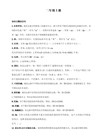
夸张通常将角色的局部或者大部分强化到极致,用来表现角色的力量和精神状态,以及给观众留下深刻的印象.三维动画中夸张主要有两种表现形式:
☆ 形态的夸张:依靠强烈的形变,超过极限的动作,给观众以强烈的印象.
☆ 效果的夸张:快的更快,慢的更慢.硬的更硬,软的更软.
☆ 静止-慢-快或快-慢-停止,这种渐快或渐慢的速度变化产生柔和的节奏感.
☆ 快-急停或快-急停-快,这种突然的速度变化产生强烈的节奏感.
☆ 慢-快-急停,由慢至快再突然停止的转折变化能产生戏剧性.
经过长期的三维动画工作,我认为最好的节奏就是你能让观众用最短的时间理解发生了什么动作.
NO.12 跟随和交迭动作(Follow-through & Overlapping Action)
跟随动作是主要动作的一种延伸,就像衣服上的飘带总是试图跟上跑步中的角色一样,所以跟随动作取决于角色的主要动作,空气阻力以及自身重量和质地等因素.交迭运动是力通过一个可以旋转的关节向下逐层传递,当前一个关节的旋转还在进行时下一个关节的旋转已经开始了,在三维动画制作中,应根据剧情发展为角色设计一些跟随和交迭动作.尽管这样会有些复杂,但是可以让角色的动作更具有趣味性.比如角色有长尾巴,长头发和长耳朵时,动画师可以为他们添加跟随和交迭动作,从而是姿势到姿势的方式制作出来的动作摆脱可怕的僵硬感.
在长期的的动画制作中,我感觉姿势到姿势的动画方式简便干净,但总体来说过于卡通化和模式化,并且通常会连带出一些多余的跟随动作,不适合写实风格的动画片.不过对于有经验的动画师来说,选择何种方式都能最终达到想要的效果.
NO.8 挤压和拉伸(Squash and Stretch)
介绍一下动画的12条基本的法则

介绍一下动画的12条基本的法则NO.1手绘伎俩(Solid Drawing)激进的手绘动画需要很是浮躁的绘画训练以及对美感的凶猛度,不外在三维动画范畴,手绘曾经再也不是动画师的工作模式.但是,无论是制作传统动画照样电脑动画,动画师都须要有火暴的绘画根底训练,才能将动画中所紧要的画面更残缺的透露表现进去.(跑车:在POSE TO POSE的动画打造中,拿起笔来绘制想要的行动,会让你更正确的驾驭团体和细节.)NO.2 排汇力(Appeal)所有的脚色都要有它吸收人的中央,无论是英雄,恶棍照常小丑.这就重要清晰的角色设定,简约的筹算,鲜白的特性,而且让脚色的举止随着故事的发展有所窜改.(跑车:一个脚色让人们从它的肢体语言看出他的所有,说到容易做到难.) NO.3 慢入慢出(Slow-in and slow-out)当现实保管中的物体入手下手运动或是终了下来的时刻,它们会履历加速和减速的人造过程.在人的行走中,人在迈出脚步的劈头与结束时运动缓解,而在两端加快,从而使整个行动更为蕉萃舒缓.NO.4 预备(Anticipation)角色完成一个行动必要履历预备,动作与竣事三个阶段.预备一般为在一个大幅度的,神速的首要行动以前,偏袒与之雷同而且相比机灵,幅度也小一些.预备动作的方针是使观众更清楚的看到动作,熟谙行动之间的肢解,否则脚色的动作会显得尤其的特立和僵硬.那末在理论产进程中预备应该运用到哪一种水准呢?这奉求于上面的一些成分:☆施加了若干力☆流动有多快☆你盼望观众有多吃惊☆在一个预备中预备能否正在发生发火,或者在一个动作中的偏袒已起头旋转☆是角色身体的一部分还是个人在为动作做操办NO.5 弧线(Acrs)使用弧线来浮现脚色的行动可以抵达尤为自然的视觉成绩,这是因为有生命的物体都是根据曲线路子来挪动的,而非完全的直线流动.例如当角色头部从左向右转时,在中间身分的时刻,头部并不是水平,儿时应该稍微低上去一些,不然观众会有生硬,受限定的感受.在三维动画中,动画师在闪现弧线流动时要寄望它的先后变动,驾驭好加/减速事理.作为动画中最常运用的一种原则,动画师必需理解力的基来源根基理,比喻重力,空气阻力,争吵力与力的传递等对弧线运动的影响和作用.才能更好的使角色行动有优美圆滑的韵律感.NO.6 节奏(Timing)节奏是角色在一个动作上所用的时间.生活中的一切物体的运动都是充满节奏感的.节奏感是由不同速度的交替变化产生的.这可能是在教授和学习动画中最难的一个环节了,每个人心中的想法和感受都是不同的,通过改变节奏可以使一个动作表现出不同的韵律和情感.☆静止-慢-快或快-慢-停止,这种渐快或渐慢的速度变化产生柔和的节奏感. ☆快-急停或快-急停-快,这种突然的速度变化产生强烈的节奏感.☆慢-快-急停,由慢至快再突然停止的转折变化能产生戏剧性.经过长期的三维动画工作,我认为最好的节奏就是你能让观众用最短的时间理解发生了什么动作.NO.7 直前与姿势到姿势动作(Straight-ahead Action and Pose-to-pose)直前动作和姿势到姿势动作是两种不同的动画技术.在直前动作中,角色不需要预先设置主要姿势,自由表演,动作捕捉和动力学模拟都属于这一类型.动画师在实际调动画时更多的是运用姿势到姿势的方法,它将运动分解成一系列关键姿势,然后让软件自动插值计算出中间的过程,从而制作出流畅的运动.在长期的的动画制作中,我感觉姿势到姿势的动画方式简便干净,但总体来说过于卡通化和模式化,并且通常会连带出一些多余的跟随动作,不适合写实风格的动画片.不过对于有经验的动画师来说,选择何种方式都能最终达到想要的效果.NO.8 挤压和拉伸(Squash and Stretch)挤压和拉伸是动画原则中的第一条金科玉律.我们在动画中为了得到一个相对稳定且又富有弹性的鲜活角色,就必须运用这条原则,对于卡通角色更是如此.它可以生动地体现角色的构成,尺寸和重量,展示力的大小(力越大,挤压和拉伸的效果越强,反之亦然),以及获得更自然的面部表情动画.在三维动画中,这种效果不能单纯靠角色表面的变化来表现,因为角色的身体是以后体积的,由内在的骨架来支撑,所以动画师在制作挤压和拉伸效果时要基于移动骨架产生形变,同事又要通过其他辅助手段来保持角色的体积是恒定的.只有这样做出来的效果才真实可信,而不会使角色看上去像一滩烂泥.NO.9 夸张(Exaggeration)夸张通常将角色的局部或者大部分强化到极致,用来表现角色的力量和精神状态,以及给观众留下深刻的印象.三维动画中夸张主要有两种表现形式:☆形态的夸张:依靠强烈的形变,超过极限的动作,给观众以强烈的印象.☆效果的夸张:快的更快,慢的更慢.硬的更硬,软的更软.想要达到好的夸张效果,需要动画师有高度的概括能力,使角色最快的表现自身的性格特点和动作风格.除了形态上的夸张之外,速度的快慢强烈对比也能达到效果上的夸张,而且这种方法能通过镜头的切换移动和后期剪辑来实现.制作时,动画师应该首先理解角色动作的目的和剧情的需要,然后再决定在哪个时间段需要夸张的处理.只有适当的,巧妙的夸张才能为动画增添可信有趣的视觉效果.NO.10 初步动画阶段(Staging)初步动画阶段,也就是我们熟悉的Layout,通过设置角色的几个最主要的关键帧把整个场景中大致的动画基调和意图表现出来.Previs(三维预览)是做到这一点的最好方式,它可以通过专业的图形软件,得到实时,细致的材质,灯光和特效.(这里推荐Motionbuilder)NO.11 次要动作(Sceondary Action)次要动作是由一系列小的运动组成的,它用来丰富主要动作的细节,增加动画的趣味性和真实性.添加次要动作要适当,既要使次要动作能让观众所察觉,又不能掩盖过角色的主要动作.例如当一个角色坐在桌子上思考,观众视线的焦点会集中在角色表情的变化上,但为了使角色的表演更为自然,动画师通常需要加一些次要动作来丰富这个主要动作,比如手指在桌面上弹几下等一些细微的小动作.制作时,动画师一般是先完成角色的主要动作,再添加次要动作来辅助角色的表演.除了肢体语言,次级在表情演绎中也广泛的应用.例如在哭戏当中,除了要表现演员哭泣的双眼,紧缩的眉头,悲痛欲绝的神情,还可以添加一些嘴唇的缠头,鼻翼的抽搐等次要动作,使得整个表演更能表现角色痛苦的深度,也能更好的感染观众.NO.12 跟随和交迭动作(Follow-through & Overlapping Action)跟随动作是主要动作的一种延伸,就像衣服上的飘带总是试图跟上跑步中的角色一样,所以跟随动作取决于角色的主要动作,空气阻力以及自身重量和质地等因素.交迭运动是力通过一个可以旋转的关节向下逐层传递,当前一个关节的旋转还在进行时下一个关节的旋转已经开始了,在三维动画制作中,应根据剧情发展为角色设计一些跟随和交迭动作.尽管这样会有些复杂,但是可以让角色的动作更具有趣味性.比如角色有长尾巴,长头发和长耳朵时,动画师可以为他们添加跟随和交迭动作,从而是姿势到姿势的方式制作出来的动作摆脱可怕的僵硬感本主题由simmer 于2010-9-29 17:15 分类收藏分享44 0 顶踩回复引用报告使用道具Black 发短消息加为好友Black (Black)当前离线天启之子。
- 1、下载文档前请自行甄别文档内容的完整性,平台不提供额外的编辑、内容补充、找答案等附加服务。
- 2、"仅部分预览"的文档,不可在线预览部分如存在完整性等问题,可反馈申请退款(可完整预览的文档不适用该条件!)。
- 3、如文档侵犯您的权益,请联系客服反馈,我们会尽快为您处理(人工客服工作时间:9:00-18:30)。
Twelve Basic Principles of Animation (1)The 12 basic principles of animation are a set of principles of animation introduced by the Disney animator Ollie Johnston and Frank Thomas in their book The Illusion of Life: Disney Animation (1981). Johnston and Thomas in turn based their book on the work of the leading Disney animators from the 1930s onwards, and their effort to produce more realistic animations. The main purpose of the principles was to produce an illusion of characters adhering to the basic laws of physics, but they also dealt with more abstract issues, such as emotional timing and character appeal.The book and its principles have became generally adopted, and been referred to as the “Bible of the industry”. In 1999 the book was voted number one of the “best animation book of all time” via an online poll. Though the original intention was to apply them to traditional, hand-drawn animation, the principles still have great relevance for today’s more prevalent computer animation. Squash and stretchThe most important principle is “squash and stretch”, the purpose of which is to give weight and flexibility to drawn objects. It can be applied to simple objects, like a bouncing ball, or more complex constructions, like the musculature of a human face. Taken to an extreme point, a figure stretched or squashed to an exaggerated degree can have a comical effect. In realistic animation, however, the most important aspect of this principle is the fact that an object’s volume does not change when squashed or stretched. If the length of a ball is stretched vertically, its width (in three dimensions, also its depth) needs to contract correspondingly horizontally.AnticipationAnticipation is used to prepare the audience for an action, and to make the action appear more realistic. A dancer jumping off the floor has to bend his knees first; a golfer making a swing has to swing the club back first. The technique can also be used for less physical actions, such as a character looking off-screen to anticipate someone’s arrival, or attention focusing on an object that a character is about to pick up. For special effect, anticipation can also be omitted in cases where it is expected. The resulting scene of anticlimax will produce a feeling of surprise in the viewer, and can often add comedy to a scene. This is often referred to as a “surprising gag”.StagingThis principle is akin to staging as it is known in theatre and film. Its purpose is to direct the audience’s attention, and make it clear what is of greatest importance in a scene; what is happening, and what is about to happen. Johnston and Thomas defined it as “the presentation of any idea so that it is completely and unmistakably clear”, whether that idea is an action, a personality, an expression or a mood. This can be done by various means, such as the placement of a character in a frame, the use of light and shadow, and the angle and position of the camera. The essence of this principle is keeping focus on what is relevant, and avoiding unnecessary detail. Straight ahead action and pose to poseThere are two different approaches to the actual drawings process. “Straight ahead action” means drawing out a scene frame by frame from beginning to end, while “pose to pose” involves starting with drawing a few, key frames, and then filling in the intervals later. “Straight ahead action”creates a more fluid, dynamic illusion of movement, and is better for producing realistic action sequences. On the other hand, it is hard to maintain proportions, and to create exact, convincing poses along the way. “Pose to pose” works better for dramatic or emotional scenes. A combination of the two techniques is often used.Computer animation removes the problems of proportion related to “straight ahead action”drawing; however, “pose to pose” is still used for computer animation, because of the advantages it brings in composition. The use of computers facilitates this method, as computers an fill the missing sequences in between poses automatically. It is, however, still important to oversee this process, and apply the other principles discussed.12 basic principles of animation:动画的12条黄金法则The Illusion of Life: Disney Animation:《迪士尼-生命的景象》Squash and stretch:压缩与伸展Anticipation:预备动作动画预期Staging:演出布局Straight ahead action and pose to pose:连续运动与姿态对应。
